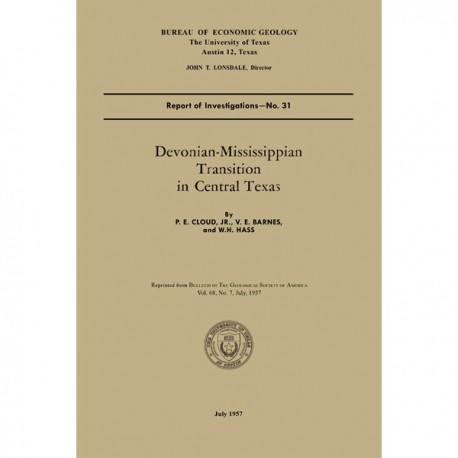Reports of Investigations
-
Books & Reports
- Reports of Investigations
- Guidebooks
- Udden Series
- Geological Circulars
- Down To Earth
- Atlases of Major Oil and Gas Reservoirs
- Texas Memorial Museum Publications
- Environmental Geologic Atlas of the Texas Coastal Zone
- Mineral Resource Circulars
- Other Reports
- Seminars and Workshops
- Handbooks
- Submerged Lands of Texas
- Symposia
- Annual Reports
- Open File Reports
-
Maps & Cross Sections
- Thematic Maps
- Miscellaneous Maps, Charts & Sections
- Geologic Atlas of Texas
- STATEMAP Project Maps
- Geologic Quadrangle Maps
- Cross Sections
- Highway Geology Map
- Energy and Mineral Resource Maps
- Shoreline Change and Other Posters
- Wilcox Group, East Texas, Geological / Hydrological Folios
- Bouguer Gravity Atlas of Texas
- River Basin Regional Studies
- Featured Maps
- Posters
- Teachers & the Public
-
Geological Society Publications
- Gulf Coast Association of Geological Societies
- Alabama Geological Society
- Austin Geological Society
- Corpus Christi Geological Society
- Houston Geological Society
- Lafayette Geological Society
- Mississippi Geological Society
- New Orleans Geological Society
- South Texas Geological Society
- GCS SEPM Publications
- Historic BEG & UT Series

Devonian-Mississippian Transition in Central Texas
RI0031
Devonian-Mississippian Transition in Central Texas, by P. E. Cloud, Jr., V. E. Barnes, and W. H. Hass. 10 p., 1 figure, 5 pls. Reprinted from Geological Society of America Bulletin, v. 68, no. 7, 1957. Print
A free, digital version of this publication can be found on: Texas ScholarWorks
RI0031. Devonian-Mississippian Transition in Central Texas, by P. E. Cloud, Jr., V. E. Barnes, and W. H. Hass. 10 p., 1 figure, 5 pls. Reprinted from Geological Society of America Bulletin, v. 68, no. 7, 1957.
ABSTRACT
The Devonian-Mississippian transition outcrops of central Texas are here described summarily and assigned to a new stratigraphic unit, the Houy Formation. The beds included are mainly Upper Devonian, but partly Lower Mississippian. Locally a basal fraction may be Middle Devonian. Although the deposits included are diverse and their associations complex, the maximum surface thickness so far known is only about 17 feet.
The principal subdivisions, in their usual ascending order, are the Ives Breccia Member (Plummer in Bullard and Plummer, 1939), the Doublehorn Shale Member (new), and a thin unnamed phosphoritic interval. Commonly, however, one or more of these members is absent, and rocks not assigned to any member are present. The Ives Breccia Member includes lag deposits of detrital chert of varied age and source. The Doublehorn Shale Member includes black, fissile, spore-bearing shale of Late Devonian age which in a few exposures grades upward into shale of Early Mississippian age. The phosphatic beds are partly Late Devonian and partly Early Mississippian. Remnants of the Doublehorn Shale Member have been found only along the eastern side of the Llano region, but the other units are more widely distributed, and rocks assignable to the Houy Formation are to be looked for between Ordovician and Upper Mississippian deposits anywhere around the Llano region.
Although most abundant in the upper beds, phosphatic inclusions occur locally throughout the Houy Formation. This gives a stamp of unity to the sequence and distinguishes it from the immediately underlying beds as well as from the overlying Chappel Limestone of later Early Mississippian age. The Houy is also a unit of more than average radioactivity and is readily detected in the subsurface by radioactive drill-hole logging.
It correlates with the Late Devonian and earliest Mississippian black-shale sequences of other Midcontinent and Midwestern areas. Four of the six conodont zones (Hass, 1947; 1956a; 1956b) in deposits of this age in Ohio, Tennessee, Oklahoma, and Arkansas are recognized also in central Texas.
Keywords: Central Texas, conodonts, Devonian, Doublehorn Shale Member, Houy Formation, Ives Breccia Member, Llano area, Mississippian, Texas
Citation
Cloud, P. E., Barnes, V. E., and Hass, W. H., 1957, Devonian-Mississippian Transition in Central Texas: The University of Texas at Austin, Bureau of Economic Geology, Report of Investigations No. 31, 10 p.
